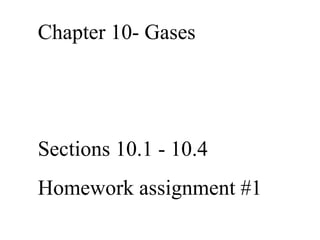
Chapter 10 Lecture- Gases
- 1. Chapter 10- Gases Sections 10.1 - 10.4 Homework assignment #1
- 3. Our atmosphere is a mixture of N 2 (78%) O 2 (21%) Ar (0.9%) others
- 16. Boyle’s Law
- 37. Section 10.4 - 10.6 Second homework assignment
- 47. For two gases under identical conditions, moles are proportional to volume. Stoichiometry can be done with volumes of gases under identical conditions. 2H 2 (g) + O 2 (g) 2H 2 O (g) 2L 1L 2L 44.8L 22.4L 44.8L
- 54. Solution Because each gas behaves independently, we can use the ideal-gas equation to calculate the pressure that each would exert if the other were not present. The total pressure is the sum of these two partial pressures. SAMPLE EXERCISE 10.10 Applying Dalton’s Law of Partial Pressures A gaseous mixture made from 6.00 g O 2 and 9.00 g CH 4 is placed in a 15.0-L vessel at 0°C. What is the partial pressure of each gas, and what is the total pressure in the vessel? Solve: We must first convert the mass of each gas to moles: We can now use the ideal-gas equation to calculate the partial pressure of each gas: According to Dalton’s law (Equation 10.12), the total pressure in the vessel is the sum of the partial pressures:
- 56. Mole Fraction For gas mixtures it is useful to define the mole fraction (X) X 1 = n 1 /n total The mole fraction or mole percent can be used to determine the partial pressures of gases in a mix IF the total pressure is known.
- 59. Section10.7 - 10.9 Homework due Thursday Gas Stoich Lab on Thursday Quiz 10 Friday Gas Stoich Lab due Monday
- 60. Ideal Gas LAW (PV=nRT) - A short statement that describes what happens (how gases behave) Kinetic Molecular THEORY - Explains why the gas laws are observed.
- 68. Gas pressure is caused by gas molecules colliding with a surface.
- 69. Gas pressure is caused by gas molecules colliding with a surface. Gas Pressure increases when the frequency of collisions or the force of collisions increases.
- 70. Gas pressure is caused by gas molecules colliding with a surface. Gas Pressure increases when the frequency of collisions or the force of collisions increases. Collision frequency increases when temperature increases because molecules move faster.
- 71. Gas pressure is caused by gas molecules colliding with a surface. Gas Pressure increases when the frequency of collisions or the force of collisions increases. Collision frequency increases when temperature increases because molecules move faster. Collision frequency also increases when the amount of gas is increased or when the volume of a gas is decreased.
- 72. Gas pressure is caused by gas molecules colliding with a surface. Gas Pressure increases when the frequency of collisions or the force of collisions increases. Collision frequency increases when temperature increases because molecules move faster. Collision frequency also increases when the amount of gas is increased or when the volume of a gas is decreased. The force of collisions is increased with rising temperature.
- 73. Using KMT to explain gas laws Avogadro’s- More particles make more collisions, increasing pressure.
- 74. Using KMT to explain gas laws Avogadro’s- More particles make more collisions, increasing pressure. Boyle’s- More volume means less collisions because molecules must travel farther. Less collisions create less pressure.
- 75. Using KMT to explain gas laws Avogadro’s- More particles make more collisions, increasing pressure. Boyle’s- More volume means less collisions because molecules must travel farther. Less collisions create less pressure. Gay-Lussac’s- Higher temp means faster moving particles. Particles collide more often and with more force. More collisions create more pressure.
- 76. Using KMT to explain gas laws Avogadro’s- More particles make more collisions, increasing pressure. Boyle’s- More volume means less collisions because molecules must travel farther. Less collisions create less pressure. Gay-Lussac’s- Higher temp means faster moving particles. Particles collide more often and with more force. More collisions create more pressure. Charles’- Higher temp means faster moving particles. Particles collide more often and with more force. To maintain constant pressure, volume must increase.
- 79. KE = ½ m v 2 At the same temperature two gases have equal KE.
- 80. KE = ½ m v 2 At the same temperature two gases have equal KE. Heavier gases must have slower velocity to keep KE constant at a given temperature. Heavier gases move slower
- 88. Diffusion occurs slower than effusion because the mean free path of molecules is reduced. Diffusion
- 92. SAMPLE EXERCISE 10.15 Applying Graham’s Law An unknown gas composed of homonuclear diatomic molecules effuses at a rate that is only 0.355 times that of O 2 at the same temperature. Calculate the molar mass of the unknown, and identify it. We can use Graham’s law of effusion to determine the molar mass of the unknown gas. If we let r x and represent the rate of effusion and molar mass of the unknown gas, Graham’s Law can be written as follows: From the information given, Thus,
- 93. Because we are told that the unknown gas is composed of homonuclear diatomic molecules, it must be an element. The molar mass must represent twice the atomic weight of the atoms in the unknown gas. We conclude that the unknown gas is I 2 . SAMPLE EXERCISE 10.15 continued We now solve for the unknown molar mass,
- 108. The van der Waals Equation ) ( V − nb ) = nRT n 2 a V 2 ( P +